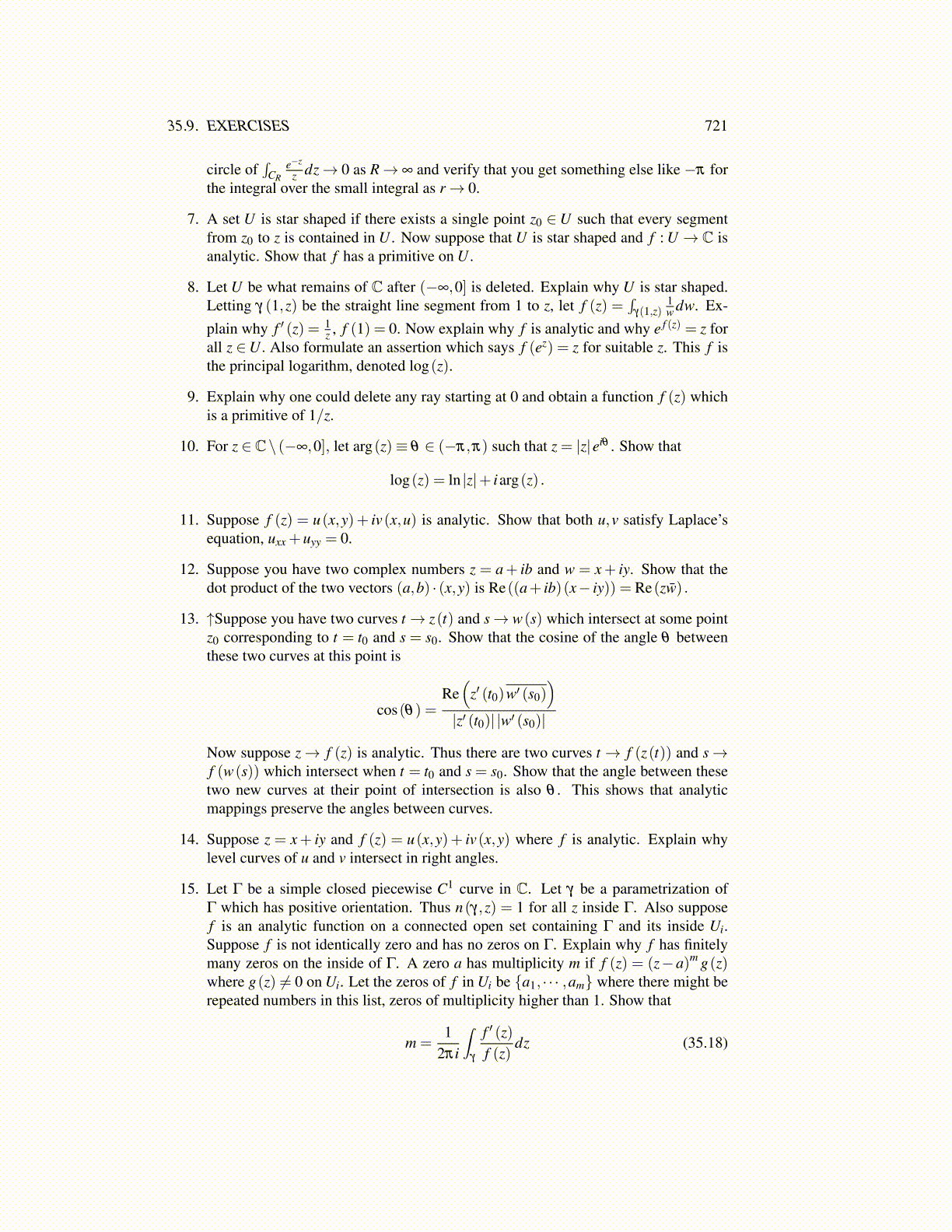
35.9. EXERCISES 721
circle of∫
CRe−z
z dz→ 0 as R→ ∞ and verify that you get something else like −π forthe integral over the small integral as r→ 0.
7. A set U is star shaped if there exists a single point z0 ∈U such that every segmentfrom z0 to z is contained in U . Now suppose that U is star shaped and f : U → C isanalytic. Show that f has a primitive on U .
8. Let U be what remains of C after (−∞,0] is deleted. Explain why U is star shaped.Letting γ (1,z) be the straight line segment from 1 to z, let f (z) =
∫γ(1,z)
1w dw. Ex-
plain why f ′ (z) = 1z , f (1) = 0. Now explain why f is analytic and why e f (z) = z for
all z ∈U. Also formulate an assertion which says f (ez) = z for suitable z. This f isthe principal logarithm, denoted log(z).
9. Explain why one could delete any ray starting at 0 and obtain a function f (z) whichis a primitive of 1/z.
10. For z ∈ C\ (−∞,0], let arg(z)≡ θ ∈ (−π,π) such that z = |z|eiθ . Show that
log(z) = ln |z|+ iarg(z) .
11. Suppose f (z) = u(x,y)+ iv(x,u) is analytic. Show that both u,v satisfy Laplace’sequation, uxx +uyy = 0.
12. Suppose you have two complex numbers z = a+ ib and w = x+ iy. Show that thedot product of the two vectors (a,b) · (x,y) is Re((a+ ib)(x− iy)) = Re(zw̄) .
13. ↑Suppose you have two curves t→ z(t) and s→ w(s) which intersect at some pointz0 corresponding to t = t0 and s = s0. Show that the cosine of the angle θ betweenthese two curves at this point is
cos(θ) =Re(
z′ (t0)w′ (s0))
|z′ (t0)| |w′ (s0)|
Now suppose z→ f (z) is analytic. Thus there are two curves t → f (z(t)) and s→f (w(s)) which intersect when t = t0 and s = s0. Show that the angle between thesetwo new curves at their point of intersection is also θ . This shows that analyticmappings preserve the angles between curves.
14. Suppose z = x+ iy and f (z) = u(x,y)+ iv(x,y) where f is analytic. Explain whylevel curves of u and v intersect in right angles.
15. Let Γ be a simple closed piecewise C1 curve in C. Let γ be a parametrization ofΓ which has positive orientation. Thus n(γ,z) = 1 for all z inside Γ. Also supposef is an analytic function on a connected open set containing Γ and its inside Ui.Suppose f is not identically zero and has no zeros on Γ. Explain why f has finitelymany zeros on the inside of Γ. A zero a has multiplicity m if f (z) = (z−a)m g(z)where g(z) ̸= 0 on Ui. Let the zeros of f in Ui be {a1, · · · ,am} where there might berepeated numbers in this list, zeros of multiplicity higher than 1. Show that
m =1
2πi
∫γ
f ′ (z)f (z)
dz (35.18)